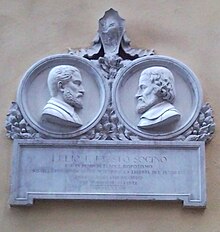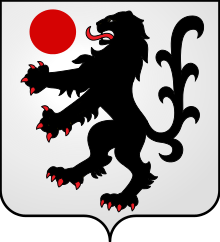
Basel-Landschaft or Basel-Country, informally known as Baselland or Baselbiet, is one of the 26 cantons forming the Swiss Confederation. It is composed of five districts and its capital city is Liestal. It is traditionally considered a "half-canton", the other half being Basel-Stadt, its urban counterpart.
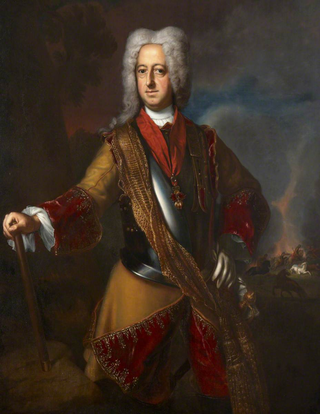
Maximilian II, also known as Max Emanuel or Maximilian Emanuel, was a Wittelsbach ruler of Bavaria and a Prince-elector of the Holy Roman Empire. He was also the last governor of the Spanish Netherlands and Duke of Luxembourg. An able soldier, his ambition led to conflicts that limited his ultimate dynastic achievements.

Lelio Francesco Maria Sozzini, or simply Lelio Sozzini, was an Italian Renaissance humanist and theologian, and, alongside his nephew Fausto Sozzini, founder of the Nontrinitarian Christian belief system known as Socinianism. His doctrine was developed among the Polish Brethren in the Polish Reformed Church between the 16th and 17th centuries, and embraced by the Unitarian Church of Transylvania during the same period.
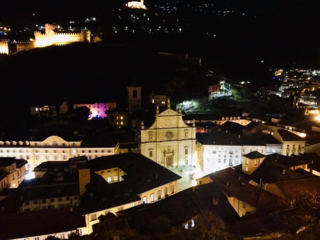
Bellinzona is a municipality, a historic Swiss town, and the capital of the canton of Ticino in Switzerland. The town is famous for its three castles that have been UNESCO World Heritage Sites since 2000.
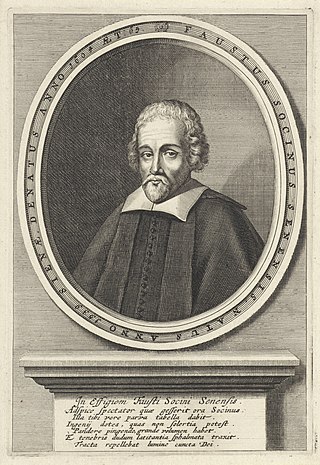
Fausto Paolo Sozzini, or simply Fausto Sozzini, was an Italian Renaissance humanist and theologian, and, alongside his uncle Lelio Sozzini, founder of the Nontrinitarian Christian belief system known as Socinianism. His doctrine was developed among the Polish Brethren in the Polish Reformed Church between the 16th and 17th centuries, and embraced by the Unitarian Church of Transylvania during the same period.

The Burckhardt family alternatively also (de) Bourcard is a family of the Basel patriciate, descended from Christoph (Stoffel) Burckhardt (1490–1578), a merchant in cloth and silk originally from Münstertal, Black Forest, who received Basel citizenship in 1523, and became a member of the Grand Council of Basel-Stadt in 1553.
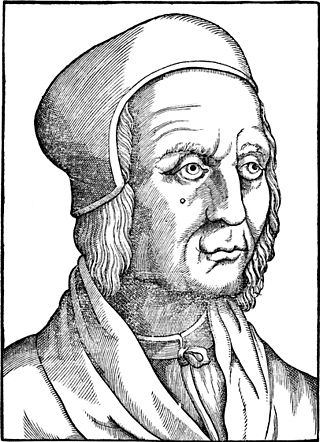
Filippo Decio or Decius was an Italian jurist whose services were courted by European universities and rulers. He was an influential representative of the pre-Humanist scholastic ius commune tradition, and one of the leading jurists of his time together with Felino Sandeo, Antonio Cocchi Donati and Bartolomeo Socini.

The Gerechtigkeitsgasse is one of the principal streets in the Old City of Bern, the medieval city center of Bern, Switzerland. Together with its extension, the Kramgasse, it is the heart of the inner city. Hans Gieng's most famous fountain figure, the statue of Lady Justice on the Gerechtigkeitsbrunnen, commands the view of the street's gentle slopes and curves.
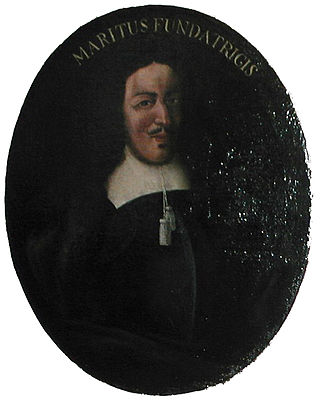
Julius Henry was duke of Saxe-Lauenburg between 1656 and 1665. Before ascending to the throne he served as Field Marshal in the imperial army.
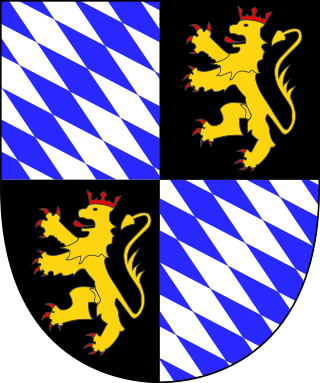
Magdalena Catherine, Countess Palatine of Zweibrücken was a Countess Palatine of Zweibrücken by birth and by marriage Duchess and Countess Palatine of Birkenfeld.

Abel Seyler was a Swiss-born theatre director and former merchant banker, who was regarded as one of the great theatre principals of 18th century Europe. He played a pivotal role in the development of German theatre and was considered "the leading patron of German theatre" in his lifetime. He supported the development of new works and experimental productions, helping to establish Hamburg as a center of theatrical innovation and to establish a publicly funded theater system in Germany. Working with some of Germany's foremost actors and playwrights of his era, he is credited with pioneering a new more realist style of acting, introducing Shakespeare to a German language audience, and with promoting the concept of a national theatre in the tradition of Ludvig Holberg, the Sturm und Drang playwrights, and serious German opera, becoming the "primary agent for change in the German opera scene" in the late 18th century. Already in his lifetime, he was described as "one of German art's most meritorious men."

Ludwig Erdwin Seyler was a Hamburg merchant, merchant banker and politician. He was by marriage a member of the Hanseatic Berenberg dynasty, and was a partner in the Hamburg firm Joh. Berenberg, Gossler & Co. for 48 years (1788–1836), for 46 years as the company's senior partner. The company name was amended in 1791 to reflect him becoming a partner and has remained unchanged since; he "is practically the 'Co.' in the company name." Seyler was one of the first merchants and bankers from modern Germany to establish trade relations with the United States and East Asia. Much of the company's wealth derived from their position as leading sugar importers from the Americas to the North European market, in combination with their activities as merchants bankers. Seyler was one of Hamburg's leading merchants during the Napoleonic Wars and held several political offices. He served as a member of the French-appointed council of Hamburg and after the Napoleonic Wars as the President of the Commercial Deputation, one of the city-state's main political bodies. Ludwig Seyler was a son of the Swiss-born theatre director Abel Seyler and a son-in-law of the bankers Johann Hinrich Gossler and Elisabeth Berenberg through his marriage to their eldest daughter Anna Henriette Gossler.

The Seyler family is a Swiss family, originally a patrician family from Liestal near Basel. Family members served as councillors and Schultheißen of Liestal from the 15th century, later also as members of the Grand Council of Basel. A Hamburg branch descended from the banker and renowned theatre director Abel Seyler became by marriage a part of the Berenberg banking dynasty, co-owners of Berenberg Bank and part of Hamburg's ruling class of Hanseaten.
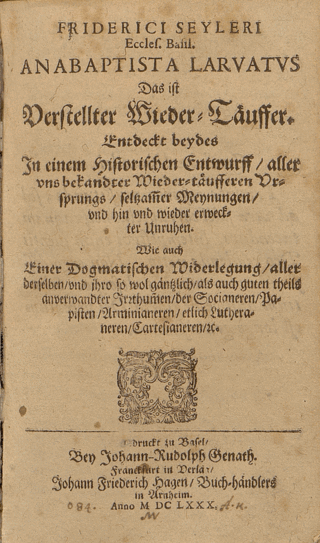
Friedrich Seyler, also spelled Friedrich Seiler, was a Swiss Reformed pastor and theologian from Basel, noted for his work Anabaptista Larvatus on Anabaptism.

Abel Socin was a Swiss merchant, politician, law lord (Gerichtsherr) and diplomat from Basel. He was a member of the Grand Council of Basel and served as the envoy of the Swiss Confederation to the French court from 1679.
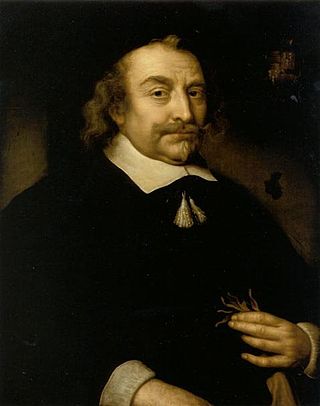
Cornelis Bicker van Swieten, heer (lord) van Swieten, was an Amsterdam regent of the Dutch Republic during the Golden Age. He traded in sugar, was a governor of the Dutch West India Company and director of the Wisselbank. He was schepen, hoogheemraad of the Hoogheemraadschap van Rijnland and a counsellor of the States of Holland and West Friesland at The Hague.

Von der Mühll or Von der Mühl is a Swiss patrician and noble family.

Remigius Faesch. was a Swiss jurist and rector of the University of Basel.
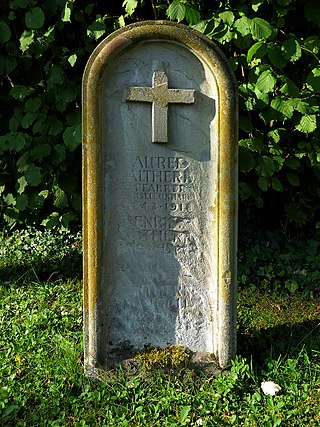
Alfred Altherr was a Swiss Protestant clergyman and writer from the canton of Appenzell Ausserrhoden.
